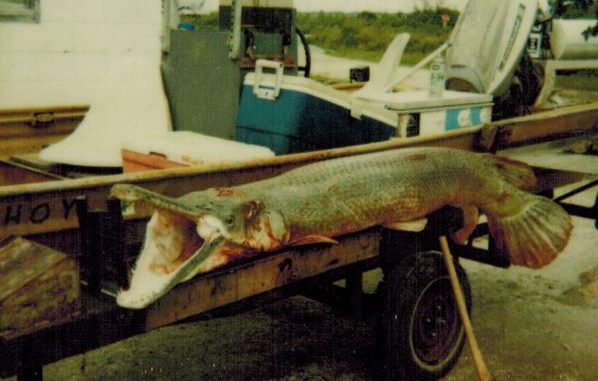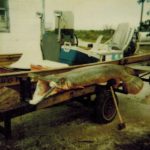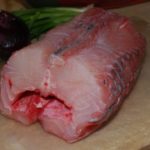
Research shows gar aren’t as bad as once thought
In the Autumn 1939, Louisiana Conservation Review (the predecessor of the Louisiana Conservationist magazine), James Nelson Gowanloch, the chief biologist of the Bureau of Scientific Research and Statistics for the Louisiana Department of Conservation, wrote an article titled “Gars, Killers of Game and Food Fish.”
The first two paragraphs of the article, in which this esteemed scientist refers to gar as “wolves of the water,” set the tone for the whole article.
“Gars are the worst single natural enemy of the fresh water game fish of Louisiana,” Gowanloch wrote. “Two species additionally inhabit both brackish and salt water, also causing immense damage there.
“Four species of gar pikes (which is their correct name) inhabit the Mississippi Valley, and in some streams and bayous their numbers are appalling.”
In the article, Gowanloch noted that their “extraordinarily rapid powers of digestion” makes them both “prodigious and persistent pests in their destruction of game and food fishes.” As an example, he cited a gar that was captured containing a large redfish, which was identifiable because the redfish carried a hook and leader broken off a line only a half hour earlier. The redfish was already well-digested.
Gar populations, he stated with some authority, were not a particular problem in unfished waters because garfish, like the other fish, were present in all sizes. However, fishing upset this balance. With their powerful, armored bodies, they were able to break free from fishing gear that effectively harvested other fish.
The escaped gar continued to feed and grow larger, while the fish species harvested by humans continued to be cropped off by nets and lines, as well as by the larger-than-ever gar. This trend continued until the food and game fishes of the water body would no longer reach desirable sizes.
So pestilential were gar considered in the 1930s that Louisiana law required anglers to kill all garfish under 12 inches in length and to slit open all gar over 12 inches long before returning them to the water.
Gowanloch did admit that gar were good table fare. “Gar fish are not only edible but delicious, although there is a general lack of knowledge of this fact,” he noted. “They dress out about 50 percent of excellent fish flesh that is both very tasty and not unusually fibrous. The writer has eaten the reportedly best game and food fishes from Nova Scotia to California and from Manitoba to Florida, yet can state emphatically that no fish that he has tasted excelled the gar in fine qualities, texture and flavor.”
By 1952, the stance of the Louisiana Department of Wild Life (yes, that is how it was spelled in those days) and Fisheries was slightly less condemnatory. In an October article in the Louisiana Conservationist, Acting Chief Biologist Harry E. Schafer Jr. wrote that the gar, which has “… been cursed as an abomination by commercial fishermen and sportsmen alike, has in recent years been winning new laurels.”
The laurels he referred to were an influx of nonresident sport fishermen to Louisiana to do battle with the monsters and a growing commercial fishery that marketed “hundreds of tons” of Louisiana garfish annually.
Still, he called a gar a “menace” and noted, “It’s undoubtedly one of the most destructive of all Louisiana’s predators, not only by its voracious appetite for other fish, but through its ability to destroy seines, nets, trawls and all sorts of fishing gear dear to the heart of the sports fisherman.”
The department’s concern was not only about the amount of game fish that gars ate but with the direct competition for food that they offered to “basses and other fish eaters.” Gar become the predominant species in fished waters, he said, because commercial and game fish are taken out by fishermen and the gar remain to fill the niche that was created by fishermen’s harvests.
During this era, the heyday of the Louisiana Wildlife Federation, virtually every parish in the state had a parish sportsman’s club affiliated with the state group. Some of their most-common and lauded activities were parish garfish rodeos, which the department helped publicize.
The ambivalence toward predators was not just confined to fish during this era. The same October 1952 issue of the Louisiana Conservationist that carried the story by Schafer printed a picture of an Elmer youngster, hailing him for killing a “chicken hawk” perched in a tree with his BB gun.
But by 1956 the department’s position on gar had shifted somewhat. In a January Louisiana Conservationist article, biologist Victor W. Lambou admitted that there is a difference of opinion as to the merits of the gar.
“Let’s put him on trial,” he said. “Is the alligator gar a terrible killer?”
Lambou began the trial by noting that some people consider alligator gars to be scavengers, enjoying dining on everything from dead chickens to the discards from fish-cleaning houses. But he used logic to conclude that many a gar has died of old age without every having the chance to feed on such refuse. Obviously, they also eat living things.
He cited a small 1940 Texas study that showed their food to include plankton, an eel, a buffalo fish and a freshwater drum. In another Texas study done in 1942, the biologist found the remains of large birds in four out of six gar stomachs.
But Lambou leaned most heavily on his own food-habits study of alligator gar in Louisiana brackish marshes in 1952. There, he found that alligator gar diets revolved around blue crabs, with nearly 87 percent of all food items being crabs.
Initially, this caused him concern because other research had shown that blue crabs and shrimp were the main food item of game fish, such as largemouth and yellow bass, in these habitats. But it became apparent that gar ate crabs that were much larger in size than those eaten by game fish.
Game fish fed most heavily on crabs less than 2 inches in size, while garfish typically ate crabs larger than 2 inches, so Lambou concluded that no competition between them existed. In fact, he said, garfish might be beneficial to game fish populations by removing large crabs, thereby leaving more food for the small crabs that bass ate. This in turn, he stated, could “raise the earning capacity of the area for game fish.”
Lambou’s judgement: “From what little information we have to go by, we cannot pronounce him a predator. We must say, rather, that he is not guilty due to insufficient evidence (emphasis is his). In brackish water, we find him possibly beneficial; we do not know enough about his relationship to other fish in other types of habitat to pass sentence.’
More modern research has supported Lambou’s relatively benign assessment. Besides their heavy dependence on blue crabs in brackish waters, alligator gar feed most heavily on striped mullet and gizzard shad, with lesser numbers of channel catfish and freshwater drum (gaspergou) in their diet. Black bass, bream and crappie made up only 13.5 percent of their food items, with most of that being bream.




